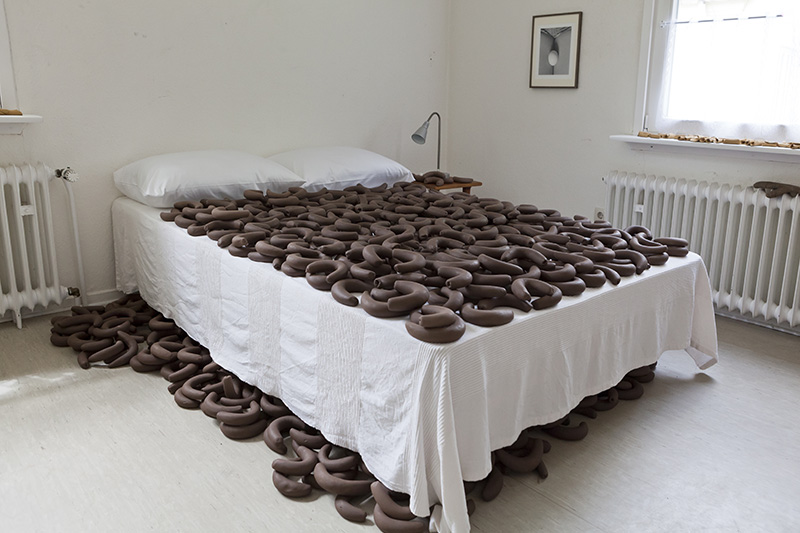ART CITIES:Los Angeles-Anna Maria Maiolino
 Anna Maria Maiolino is one of the most significant artists working in Brazil today. In a career spanning five decades and a diversity of disciplines and mediums, ranging from drawing, sculpture and artist books to video and performance, she expresses through her work a bottomless concern with creative and destructive processes and, above all, the never-ending search for identity.
Anna Maria Maiolino is one of the most significant artists working in Brazil today. In a career spanning five decades and a diversity of disciplines and mediums, ranging from drawing, sculpture and artist books to video and performance, she expresses through her work a bottomless concern with creative and destructive processes and, above all, the never-ending search for identity.
By Dimitris Lempesis
Photo: MOCA Archive
Anna Maria Maiolino’s multidisciplinary practice has consistently explored the viscerality of embodied experience, often obliquely through fragmentation and abstraction and engaged the human body’s processes as analogs for both the making of art and the making of modernity. As an immigrant coming of age in politically unstable Brazil, Maiolino has perfected a dialogue between opposite yet complementary categories in a practice that dissolves dichotomies of inner and outer, self and other. Hers is an art in search of a new language for the liminal realm of daily human existence. The first comprehensive U.S. museum retrospective of Anna Maria Maiolino’s work is on presentation at the Museum of Contemporary Art, Los Angeles (MOCA). The exhibition covers the full range of Maiolino’s oeuvre from the early ‘60s through the present with an equal focus on its socio-historical dimensions (issues of migration, linguistic competence, feminism, dictatorship) and the ever-present dialectical tension between art and life, between the timeless and the everyday, between what can be said and what is felt. Born in wartime Italy in 1942, Anna Maria Maiolino immigrated with her family to South America in 1954, living first in Venezuela and moving to Rio de Janeiro in 1960. “I found myself being an immigrant again, without speaking Portuguese. What kept me going was my obstinate search for a language, my obsession to become an artist. All my energy was spent trying to become an individual. The existential and art formed one anguished body. My life was dominated by anguish and doubts, although I also wanted to participate in that moment of great political, social and artistic effervescence that was pushing artists to make alliances with the previous generations… We wanted to develop an autonomous national art, far removed from external patterns and models. We dreamt of a free and autonomous Latin America, with its own economic resources, and art was no different in this respect”. Maiolino’s early experiments in the ‘60s connected her to important movements in Brazilian art history, shadowed by the turmoil and governance of military dictatorship: Neo-Concrete, New Figuration, New Objectivity. Maiolino took part in the radical reconfiguring of the art object during this period. Along with Lygia Pape, Lygia Clark, and Hélio Oiticica, Maiolino participated in the 1967 exhibition “New Brazilian Objectivity” which symbolized a cultural shift in previous constructivist traditions and established a new vision for the production of art in Brazil. She lived in New York from 1968 to 1971 where she was exposed to Minimalism and Sonceptualism. Returning to Brazil, she began to use film and performance. “In-Out (Antropofagia)” (1973) furthered her interest in the mouth as a site of consumption, this time linking it to specifically Brazilian theories of cultural cannibalism. Meanwhile, her performance work started to address the ramifications of the dictatorship on personal and cultural freedoms. For these works, Maiolino often used eggs, a material that resonates with her particular strain of dialectical thinking, rife as the egg is with associations of gender, fertility, food, and the play between hard and soft, durable and delicate. After the end of the dictatorship, Maiolino discovered clay, a material that continues to sustain her attention. Clay allows her to make the large, sculptural, room-based installations which are also part of this exhibition. She does not fire the clay, so the nature of time,particularly the daily, cyclical, repetitive nature of “women’s work” and the larger philosophical issue of impermanence, is a major idea in her oeuvre.
Info: Curators: Helen Molesworth and Bryan Barcena, The Museum of Contemporary Art (MOCA), 250 South Grand Avenue, Los Angeles, Duration: 4/8-31/12/17, Days & Hours: Mon, Wed & Fri 11:00-18:00, Thu 11:00-20:00, Sat-Sun 11:00-17:00, www.moca.org



